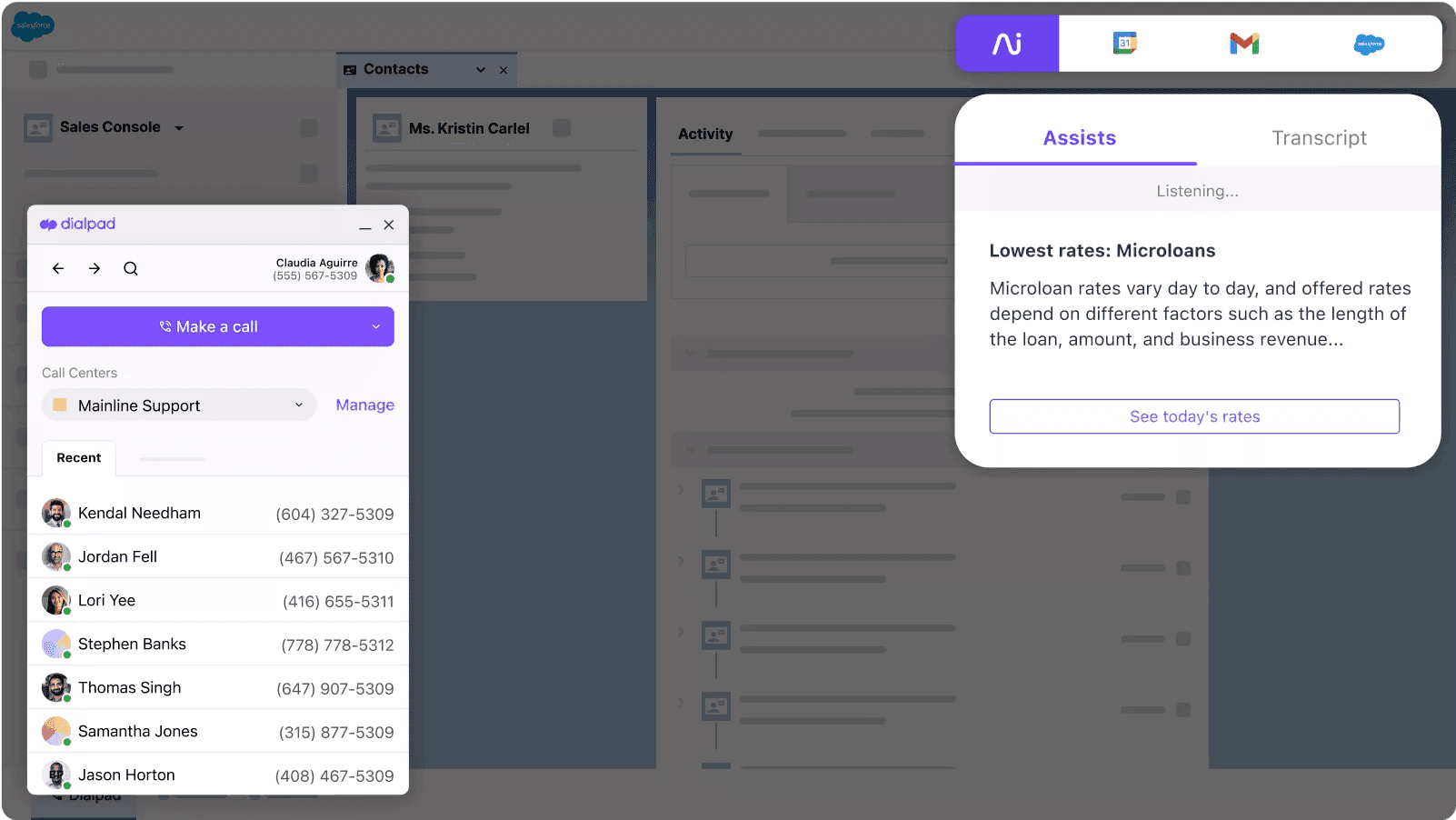
Tags
Share
Dialpad is where all your work comes together—and that includes your favorite business apps.
We designed Dialpad to make communicating with colleagues and customers seamless, no matter what tools you’re using. That’s why we offer over 45 out-of-the-box integrations in the Dialpad App Marketplace that plug directly into CRMs and productivity suites like Salesforce and Google as well as directly into the Dialpad environment.
And if you can’t find what you’re looking for, Dialpad’s open API has over 140 endpoints that allow you to build custom workflows like voice archiving, agent management, AI-generated transcriptions, SMS apps, and more. We also partner with multiple ISVs (independent software vendors) to bring the best communication and contact center integrations to market to promote better experiences and workflows for our customers.
Save time and automate your workflows with Dialpad integrations
Integrate your favorite apps like Google Workspace or Microsoft 365 to help manage your calendar, access files, and call or text in your email workspace. When you sync your Google or Microsoft 365 contacts with Dialpad, you can view emails, files, and calendar events with your contact creating a single pane of glass for all your business communications in Dialpad.
Or, bring Dialpad into your CRM to provide better customer experiences and close deals faster. The Dialpad for Salesforce integration brings smarter workflows, increased call efficiency, and automatically synced customer interactions to Salesforce so your teams can focus on driving more sales.
Dialpad automatically syncs contact details and logs activities like call history, recordings, voicemails, transcriptions and notes directly from Salesforce to your Dialpad apps:

Dialpad also integrates with Salesforce's power dialer and omnichannel capabilities to drive efficiency for both sales and support teams. Working in your own custom CRM? The Dialpad Chrome CTI can be configured to work in any Chrome browser tab to bring all your communications and contact center workflows into your preferred web page:

Open your conversations to do more with Dialpad APIs
When you build a custom private or public integration with Dialpad, you can customize the app to work the way you want. With over 140 API endpoints, building an integration or workflow to meet a specific business need is a breeze.
Here are a few of our most popular APIs.
Call routing API
The Dialpad Call Router API offers a way to connect calls to an API call router that can either be reached by a dedicated DID or routed from a mainline menu. Once the call gets to the call router, it will notify the subscribed webhook that a call reached the call router and wait for a response from the client application.
The client app can then perform a customer/business side logic, like playing a message and asking for information, performing a data dip for an Order Number/Quote ID/Case Number and/or command the call router to route calls to an agent or a group.
Screen pop
A screen pop (or call pop) is usually tied to a CRM or ticketing application integration, or something similar, and allows developers to pop open a browser window, on command, and direct their operators to a specific page with relevant information about the caller, or a form to create an activity:

Screen pop also allows launching native apps. API specification is available here.
Dialpad CTI
The Dialpad CTI offers a way for clients to embed a Dialpad device to their system or app of choice. The CTI is an iFrame component that offers Dialpad functionality in a small package, like call control, SMS, contact browsing, call center status and DND control. It can be instantiated in virtually any system as long as your Dialpad OAuth app and website allows it. If you’re working in a custom CRM, you can embed the Dialpad CTI into the CRM to make and receive calls, click to dial, and more with Dialpad.
Learn more about the Dialpad CTI →
The Dialpad CTI can be surfaced in three different forms:
Through our natively supported Dialpad integrations. This means the CTI is available out of the box in an application built by Dialpad. These integrations include our Salesforce, Zendesk, and HubSpot integrations.
The Dialpad Chrome Extension. Looking to use the Dialpad CTI to communicate in a specific Chrome browser tab? If you spend a significant amount of time using the Chrome browser, you can configure the Dialpad Chrome extension to work in the websites of your choosing.
The Open CTI: Embed the Dialpad CTI into your own application or website. This is especially helpful for organizations that might be using their own home-grown / custom CRM or applications. We make it simple for you to add voice and contact center capabilities to your own environment by embedding a few lines of code with the Dialpad Open CTI.
It’s important to note that the CTI will not be integrated with the webpage but it will allow the clients to embed a Dialpad device as a complementary feature to an event-based integration.
SMS and call APIs
SMS and call endpoints allow clients to send SMS, MMS and initiate calls programmatically. Have you ever received a text message or call confirming your appointment at the dentist’s office or another place of business? This was most likely built using an SMS or Call API!
Many businesses find that these programmatic SMS and Call APIs help them save time confirming and rescheduling appointments, plus most people like receiving a text or call to confirm quickly without having to take time out of their busy day. SMS APIs can be integrated with messaging interfaces for customers that would like to use Dialpad as their underlying messaging system and the Call API can be used to create a “native” click-to-call functionality or integrate with a contact page that has a call action.
Well, what are you waiting for? Developers can request sandbox access and OAuth access by filling out these respective forms.
Event subscriptions
Dialpad’s event-based mechanisms allow customers to create event subscriptions to Dialpad targets (company, office, call center, department, or user) and be notified whenever a predetermined condition is met. For instance, they can create a call event subscription to be notified whenever a call is ringed and/or is picked up by one of the agents. And when that condition is met, Dialpad will send information to the webhook registered in the subscription so that the customer can analyze the information and log it in their system as an activity, ticket, contact, etc.
Learn more about Event Subscriptions →
Take it a step further with the Dialpad App Partner Program
After building your integration, you can make it public by posting it on the Dialpad App Marketplace. This allows more Dialpad customers to discover and start using your integration while boosting your brand presence by gaining exposure on the marketplace. After posting to the marketplace, you’re eligible to receive extensive go-to-market opportunities with Dialpad.
Dialpad App Partners
Use Dialpad App Partner+ and Strategic partner integrations with ease knowing they are supported and maintained by Dialpad and our trusted partners. We partner closely with these ISVs to bring best of breed integrations with apps in multiple categories such as CRM, customer service, workflow automation, legal software, and more.
Learn more about our program in the Dialpad Partner Benefits and Resources guide.
Want to check out how Dialpad can integrate with the tools you’re using? Visit the App Marketplace to get started with Dialpad out-of-the-box integrations.
Want to create something cool with us? Build something great at developers.dialpad.com.










